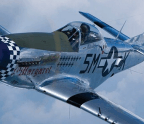
IN ONLY 30 MISSIONS, Capt. Ralph S. Parr downed 10 enemy aircraft, becoming the 11th double jet ace on the last day of the Korean War.
Having just landed from a combat mission, the four of us were walking casually from our squadron’s sandbagged revetments towards the operations building, when the deafening engine whine of another returning flight of F-86 Sabrejets caught our attention. At the time, all fighter-interceptor pilots instinctively checked the gun ports of returning flights for the dark gray soot, indicating their guns had been fired. This would imply contact with MiGs. And sure enough, the .50-caliber blast shields of one aircraft showed the unmistakable signs. But something else about it looked odd: The ship’s entire fuselage was very badly scorched from nose to tail as if its paint had been singed with a giant blowtorch.
The date was June 7, 1953, and Capt. Ralph S. Parr was returning from his sixth combat mission in the Sabrejet. Their mission had been a fighter sweep—to intercept and destroy any and all enemy aircraft found over North Korea. His fouled gun ports and his scorched airplane were visual confirmation of the first two of his soon to be 10 aerial victories.
Blooding his Sabre
Despite his extensive stateside Sabrejet experience, and having already completed a combat tour in F-80 fighter-bombers, at the time Capt. Parr was considered a “new-sport” in the 4th Fighter Interceptor Wing’s 335th Fighter Interceptor Squadron. This required him to first fly in a support role as wingman, before acting as element or flight leader and actually initiating an attack and firing his guns. In fact, he relates that his first few missions were nothing more than practice formation flights.
On this fateful mission, Shark flight consisted of four F-86Fs flying a “fluid element” tactical formation—euphemistically called the “fluid-four.” This formation allowed the flight leader to search ahead for bandits,




